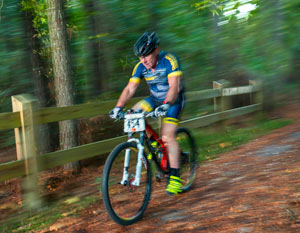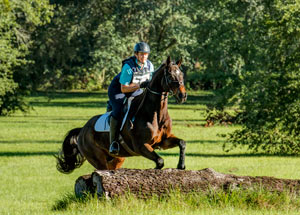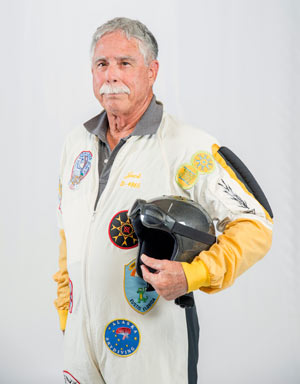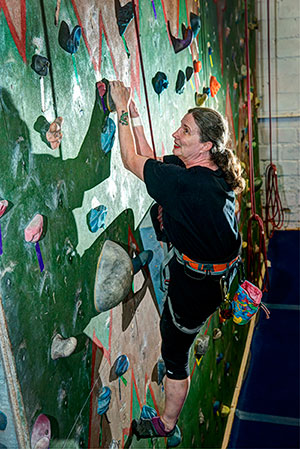
By definition, a daredevil is a recklessly bold person. Although definitely bold, the local senior daredevils featured in this article are not reckless. They’ve spent years honing their skills to excel in their sport of choice. And although what they do makes the rest of us look on in awe, intrepid would be a more apt description for these individuals. Whether tackling challenging rocky trails, climbing mountains, conquering obstacle courses on horseback or falling through the sky, these adventurous seniors prove that a courageous spirit is truly ageless.

Steve Agronick
Mountain Biker
When the going gets tough, the tough get going could be mountain biker Steve Agronick’s mantra. Throw in some rocky trails with steep elevation climbs and Steve becomes a happy super biker. Or more to the point, a national champion.
At 71, Steve won his age group (70-74) at the 2014 USA Cycling Cross Country MTB Nationals this past July 17-20 in Macungie, Pennsylvania. The win qualified him for the UCI Mountain Bike Masters World Championship in Lillehammer, Norway, August 22 through 27. And there he finished third, earning a bronze medal in his age group.
The MTB Nationals’ championship cross country course in the Poconos Mountains definitely met and exceeded the tough-going criteria. It began with an elevation climb of three and a half miles and then dipped down into a rock garden; another mile climb led to rock-strewn forest trails over more than two miles for a total of seven miles. Then the riders had to repeat the course!
But the World Championship 12-mile course was even tougher.
“It was absolutely brutal,” says Steve, a retired mechanical engineer who took up mountain biking 25 years ago. “It was extremely rocky, and you were always climbing. It took almost everything out of me to finish it. But I love a challenge.”
Indeed he does. Prior to mountain biking, Steve rode in motocross events for more than 20 years. During that time, he rode professionally and competed internationally for corporate sponsors based in Spain and Germany. But motocross exacts a toll on the body, and Steve knew when to move on.
“When I retired from motocross, I knew I still wanted to be active,” says Steve, who lived in upstate New York at the time. “I knew of people of who did mountain biking, so I tried it and have been doing it ever since. I discovered the Cross Florida Greenway biking trails when my wife, Eileen, and I regularly visited her parents in The Villages.”
The Greenway’s bike trails made retiring to The Villages an easy decision for Steve and Eileen in 2004. But Steve didn’t stay retired. Soon he was working full time at Village Cycles, describing it as “the perfect job for a biker.”
Steve, who owns six bikes, logs 15 to 18 hours a week training on both the Greenway trails and the roads. He also does weight training because he says that “people don’t realize you have to have great upper body strength to stay upright while going over rocks and roots, uphill and downhill.”
But sometimes all the training in the world isn’t enough on perilous mountain trails. A few years ago at a race in Connecticut, Steve flipped over the handle bars into the rocks. He woke up in an ambulance with broken ribs, a broken wrist and a shattered face that would take seven surgeries to fix.The accident kept him off the bike for a year but didn’t diminish his affinity for the sport.
“I love the camaraderie and the festive atmosphere of the mountain biking events,” says Steve, who usually competes in 20 to 25 races a year. “And, of course, the fitness aspect and challenge of the sport. The tougher the better is what gets me going.”

Carol Ogden
Cross-Country Equestrian
Think American Ninja Warrior on horseback and you have a good idea of what cross-country competition is in the equestrian world. Rider and horse, mostly at a gallop, must complete a previously unknown course by jumping fixed obstacles of varied sizes, widths, shapes and materials, including water hazards, in the allotted optimum time. If a horse refuses, runs around or past a jump, that’s a penalty. If the rider or the horse falls on the course, that’s a penalty. If the pair goes over the optimum time, that’s a penalty. Cross country is all about the trust between horse and rider, focus, stamina and, of course, speed. All of which attracted Carol Ogden to the sport 40 years ago.
“Cross country is such a rush. You’re moving very fast, and the obstacles are coming at you very quickly. To be successful, you and your horse have to be in sync,” says Carol, 66, a lifelong horsewoman. “And doing well in cross country, with you and your horse finishing safe and sound, is an unbelievable rush.”
Cross country is part of the equine sport of three-day eventing, which also includes dressage and stadium jumping on separate days. Three-day eventing is considered the ultimate test of a horse and rider’s all-around athleticism.
Carol’s equine partner is Brogan, a 16-year-old Thoroughbred gelding she raised from about 6 months old. Brogan, who never raced, is a grandson of the great racehorse Secretariat. His registered Thoroughbred name is Secret Deal while his official show name is In Rhythm.
“I like to go fast, and Brogan likes to go fast, so we make a good team,” says Carol, who when she isn’t in the saddle works in the Sears accounting department. “Brogan has that innate love of running like Thoroughbreds do. But he’s also a very sensible, fun horse and a road warrior.”
Carol and Brogan will generally begin a conditioning regime six weeks before an event, and they are regular visitors to the Florida Horse Park. Usually, the training sessions are about an hour long, four to five days a week, with alternate days of dressage, stadium jumping and cross country work. Schooling shows also help the duo prepare for the four to five major events they compete in a year throughout the southeast region. Sometimes weather becomes another obstacle on the course; competitions are held rain or shine with only lightning stopping an event. The Masters class that Carol and Brogan compete in are generally a mile and a half course with 20 to 22 obstacles; optimum finishing time of five to five and a half minutes.
Brogan and Carol have been a successful team, winning so many ribbons over the years that Carol made a quilt with some of them. Thanks to the entry fees to compete in the events, Carol calls it “my $100,000 quilt.”
“As long as Brogan and I are healthy and enjoying cross country, we’ll keep on competing,” says Carol. “I love the challenge and riding Brogan. And after all, I need more ribbons so I can make a couple of matching pillows to go with the quilt.”

Jack La Londe
Skydiver
Jack La Londe’s idea of a good time with his closest friends is falling out of the sky together at 110 miles an hour. Then, while plummeting toward the ground, La Londe and his skydiving buddies maneuver toward each other, linking hands and feet to create geometric patterns. All in the name of friendship and fun for 75-year-old La Londe.
“I started skydiving with friends on a dare,” says La Londe, a retired glass maker and installer. “We were looking for something thrilling to do and someone suggested skydiving. So off we went.”
An honest man, La Londe admits being afraid during those early years of jumping.
“I was petrified at first,” says La Londe with a chuckle. “When we started jumping in 1968, we used old military gear, and that was a whole lot different than the equipment we have now. It was bulky, and you weren’t always sure if it was going to work. It probably took me about 100 jumps before I wasn’t so scared anymore.”
That was 46 years ago; 5,700-plus jumps and counting.
After just falling through the sky became a little blasé, La Londe began sky diving competitively. He started doing formation diving in 1976 and then added sport accuracy diving in 1980. One of the latter’s competitions involves jumping out of a plane from 4,500 feet and landing in a standing position on a designated target; the skydiver does three jumps in an attempt to land in the six-foot in diameter target’s center. This past March at the annual Lake Wales, Florida, skydiving competition, La Londe finished second in the sports accuracy division.
“I hadn’t done sports accuracy jumping in a while. It’s really a younger man’s game, but with age comes wisdom,” says La Londe, who has been attending the Lake Wales event for 35 years. “But my favorite is formation diving, particularly 10-way, but I will do up to 40-way.”
In 10-way non-competition formation skydiving, a team of 10 jumps out of a plane at an altitude of 13,500 and is falling through the sky at about 110 miles an hour. The link-up among the skydivers takes place during 60-65 seconds of free-fall time. The latter is the time before opening parachutes. The skydivers generally break apart at 4,000 feet and then open their parachutes at 3,000 feet.
“The best part is when you’re in the sky,” says La Londe, adding wryly, “We skydivers like to say that the sky is our friend, but the ground, not so much.”
Over the years, La Londe has held several formation world records, including a 20-way for skydivers over 40 and a 36-way for skydivers over 70. In the past four years, he has been involved in four records for jumpers over 70, including 11-, 16-, 18- and 20-ways.
Remarkably, the only skydiving injury La Londe has incurred over the years was to his left knee on a landing. He eventually had to have knee replacement surgery four years ago. And despite the doctor’s orders not to jump for at least six months, La Londe was back in the sky in less than three months. When La Londe, who averages 120 jumps a year, isn’t out of town or state at skydiving events, he can be found jumping at Skydive Palatka.
“My goal is to jump for 50 years straight and make at least 6,000 jumps,” says La Londe, who has six grandchildren, none of which have inherited his affinity for skydiving. “I love being in the air and spending time with my friends jumping together. It’s an amazing experience to share with your friends.”

Sarah Bewley
Rock Climber
What do you do if you’ve had a lifelong fear of heights? Well, if you’re Sarah Bewley, you learn to rock climb at 55 and, oh, with an arthritic hip.
“I had been a runner from my late 20s to my early 40s,” says Sarah, 61, an award-winning playwright who graduated from Ocala’s Forest High School. “I was a fairly serious runner and ran in the New York City Marathon. But when I developed osteoarthritis in my right hip, I had to give up running. It was very frustrating to go from being very active to not being able to do much more than just walk.”
No longer able to run, Sarah’s fitness level declined, she gained 40 pounds and, as she says, “felt like a slug.” The answer to her exercise dilemma, a very surprising one to height-challenged Sarah, came from writer and friend Kij Johnson.
“Kij is a rock climber, and she’s so passionate about it that she writes a blog about it,” says Sarah. “Kij feels about climbing the same way I felt about running. Her writing made rock climbing sound so wonderful, and she encouraged me to give it a try.”
After a little research, Sarah contacted Ken Hyneman at Gainesville Rock Gym. She told him right from the get-go that she was “terrified of heights but really wanted to try rock climbing.” Hyneman offered to set up a personal training session with her in the morning before the gym even opened, allowing her to try it without others around and the noise of the busy gym. Sarah took him up on the offer. Her first lesson was on a beginner’s wall, which is 25 feet high but more slanted than vertical.
“I actually managed to make it to the top of that beginner’s wall,” says Sarah. “When I got back down, I had this big goofy smile on my face and told Ken that I wanted to do it again. Rock climbing was an instant love affair for me.”
A year and a half later, Sarah was climbing Foster Falls in Cumberland State Park, west of Chattanooga, Tennessee. Foster Falls is a popular location for sport climbing, featuring strenuous vertical climbs that average 60 feet in height. Hyneman led a group of climbers into the park for an overnight camp stay that included two days of climbing.
“We had a very difficult long hike into the area where we were going to camp,” says Sarah. “And as soon as we got there, we did our first climb. The feel of the rock was just so different than the gym’s rock walls and just gave me an incredible jolt of energy. We’d reach the top, rappel down on the ropes and then do it again. We climbed for about an hour each day. It was the most amazing experience I’ve ever had.”
With her fear of height vanquished and no issues with her arthritic hip, Sarah has climbed rocks in Georgia and Alabama. To stay in shape, she goes to the rock gym three times a week and has progressed from that 25-foot beginner wall to 100-foot walls with much more technical difficulty.
“Rock climbing is such a great workout, physically and mentally,” says Sarah, who’s once again fit. “You have to use your physical strength, but you also have to think and figure out your ascent and descent. I get great satisfaction out of rock climbing, and my goal is to be climbing when I’m 80.”






